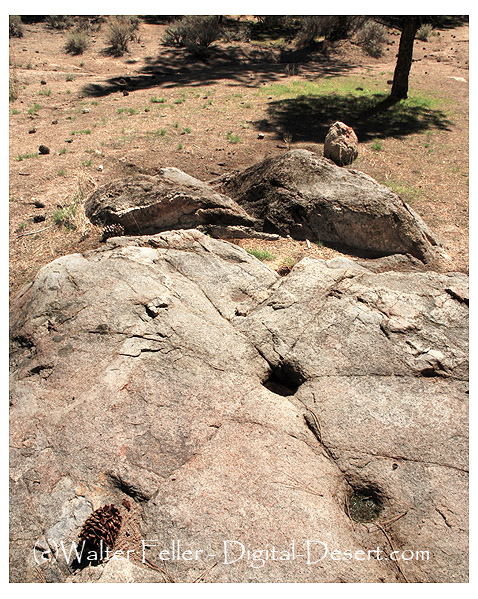Communal Bedrock Mortar
MORTARS AND PESTLESFor pulverizing food the characteristic stone implements were the bedrock mortar (tco'se, P, N, C, S) and the cobblestone pestle (ho'pa, P; kawa'tci, N, C. S). Plate XXIX, fig. 2, and Kroeber’s Handbook, plate 45a, show mortars in level granite outcrops.
The bedrock mortar was at first a slight natural depression in a granite boulder. With the wear of the pestle a cup (tcose, C, S) was formed. When a cup became too deep, a new one was started a few inches or a few feet away. Such a boulder served as the communal milling place for all the women of a hamlet. Deep mortar holes were used for the preparation of manzanita berries, oats, and other seeds, especially when it was desired merely to crack the shells and not to crush the meats, previous to winnowing. In such a case the pestle was used lightly and also worked sidewise in the hole.
Unworked stones of convenient size and shape served as pestles. These were found in large numbers in the beds of the many mountain streams of the region. Examples are shown in plate XXXIII, figs. 1-6.
With the bedrock mortar no basketry or other hopper was employed. Consequently, the meal, as it was pounded, spread out over the surface of the rock, and particles often flew over a radius of two or three feet. To collect these particles and to keep the meal heaped about the grinding cup, a soaproot brush (caka'ni, P, N), plate XXXVI, was used at frequent intervals.
When no convenient bedrock mortar was at hand, a flat stone, sufficiently small to be portable, was placed in the floor of the dwelling or grinding house (plate XXX, fig. 2). Such a mortar was called ütü'we (P), ülü'we (N), u'mme (C, S), te'sa (C). Holmes shows two such at a mealing place.76
Of less importance was the globose, portable mortar, called ü'mme (P, N), wowi and ho'lisu (C), kuyo'pa (S). The Miwok made no portable mortars whatever. All in their possession have been found by them and are said to have been made by Coyote, a supernatural being, who scratched them out or made them sexually. Small portable mortars are shown in plates XXXIV and XXXV, figs. 1-3, and Holmes pictures some.77 The larger were used for grinding dried meats and fish, especially for old people whose teeth were poor, and for making some kinds of seed meal. Small mortars of this type were employed in grinding medicines and paints. The pestle for such a mortar is called kiwapula (C). With these mortars were used small, carefully shaped pestles (plate XXXII, figs. 5, 7, 8, 10).
Two Northern Miwok mortars, 1-10011 and 1-10504 in the University collection, one of which (1-10011) is illustrated in plate XXXV, fig. 3, show double use. They are small, irregularly shaped meat and nut mortars. On their bottoms are little depressions upon which acorns were held when cracked.
Wooden mortars (umme, C) were said to have been made by the Central Miwok. In them were used stone pestles.
———
76Holmes, 1902, 172, pl. 13.
77Holmes, 1902, pl. 9.
Miwok Material Culture: Indian Life of the Yosemite Region (1933) by S. A. Barrett and E. W. Gifford
